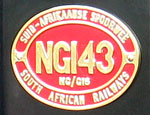|
143 is one of four Beyer-Garratt NGG16
(2-6-2 + 2-6-2T) locomotives, formerly from South Africa, that
provide the power for the new Welsh Highland Railway. These are the
most powerful narrow gauge locos in the world, which is necessary to
cope with the hard gradients of up to 1 in 40 along the line pulling
up to 12 coaches.
Sourced via the Alfred County Railway alongside No. 138, 143 was
overhauled and converted to oil burning in South Africa, before
arriving in Wales in early 1997. Both 138 and 143 were originally
ordered by the Tsumeb Copper Corporation in 1958. However its line
was altered to a different gauge and South African Railways took
over the order instead. They were part of a batch of seven NGG16s (No.s
137 to 143), the last steam locomotives built by Beyer Peacock of
Manchester.
143 entered service in September 1998, a year later than 138 after
receiving significant attention, particularly to her boiler. Much of
this work was carried out at the specialist works of Riley and Son,
Bury. She was the last locomotive built by Beyer-Peacock of
Manchester, contrasting with K1 - the first Garratt locomotive to be
built in 1909. She sports a very tidy South African Railways black
livery.
|
Gallery: |
|
1
2
3
4
5
|
|
143 steams towards Rhyd Ddu, dwarfed by the slopes of Snowdon in the background.
|

|
|
|

NGG16 No. 143
Built:
1958 - Beyer Peacock, Manchester, UK.
Entered service on WHR: 1998
Wheel arrangement:
2-6-2 + 2-6-2T
Weight:
Approx. 62 Tonnes (In working oder)
Fuel: Oil
Boiler Pressure:
180 pounds per square inch.
Cylinders:
4 x 12" diameter, 16" stroke
Tractive Effort @ 85% pressure:
21,553lbs.
|
|

